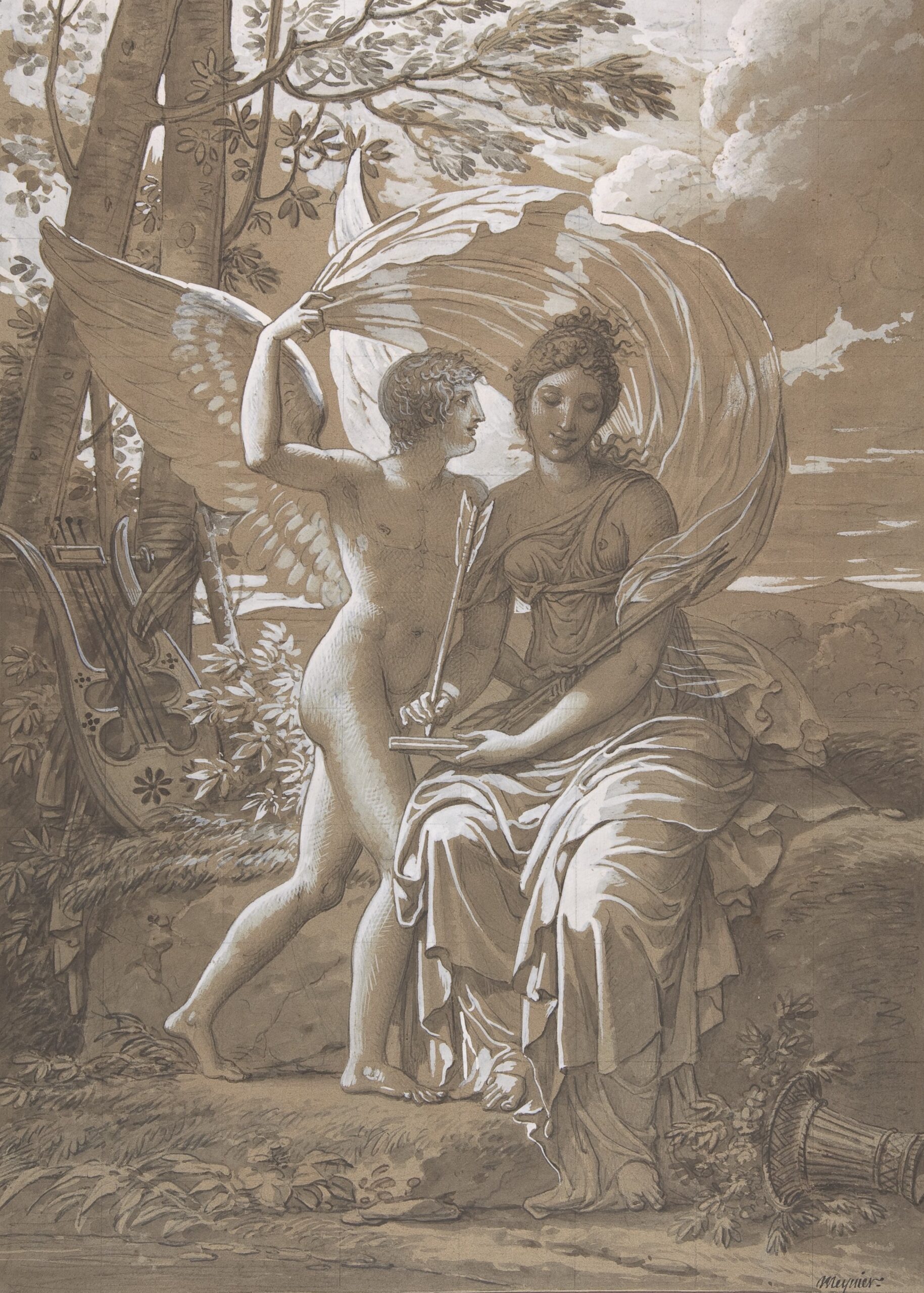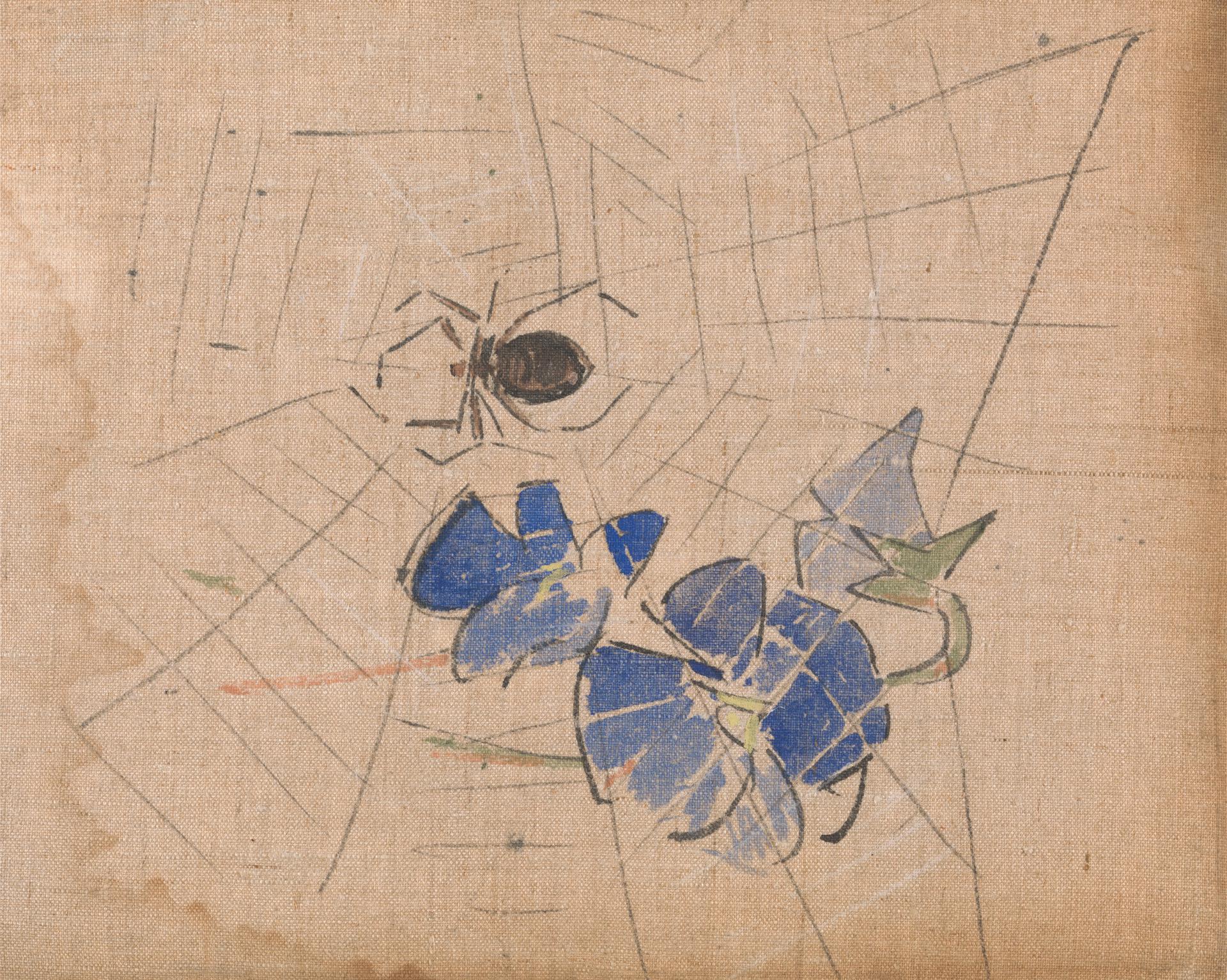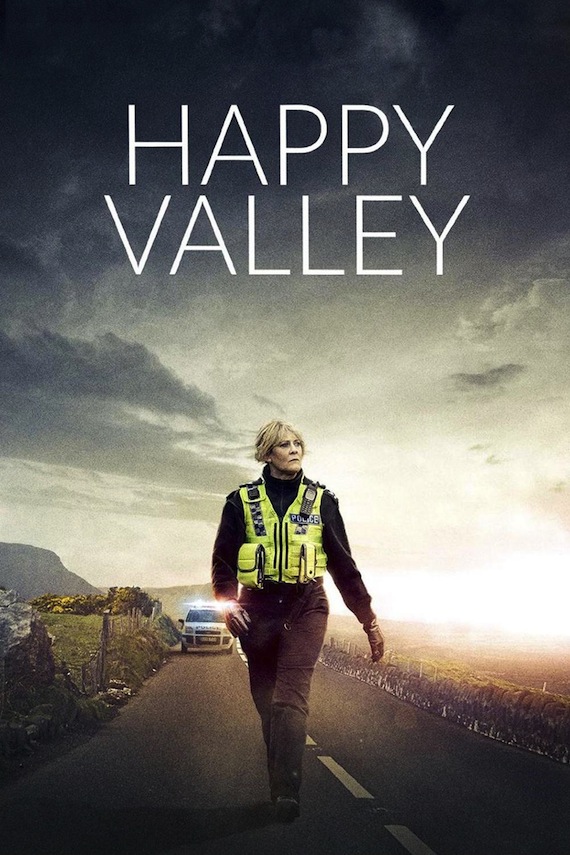
Netflix’s Happy Valley is known for being mumbly — many North American viewers watch with the subtitles on. The Yorkshire-speak is unabashed, as is the crying: longtime cop Catherine Cawood (played by Sarah Lancashire) solves crime while suffering metastatic personal tragedies. As she notes in the opening episode, “I’m 47. I’m divorced. I live with my sister, who’s a recovering heroin addict. I’ve two grown-up children, one dead, one who doesn’t speak to me, and a grandson. So.” The grandson is her dead daughter Becky’s child, conceived in a rape. Season One (2014) has Catherine on a kidnap case, not knowing at first that one of the criminals involved is Becky’s rapist, Tommy Lee Royce (James Norton). In Season Two (2016), Royce is in prison, using a besotted woman to get at Catherine while she investigates a series of sexual murders.
Visually, the scenes are clear-edged; the landscape green, the huge sky often piled with clouds. References to the grey-brick towns and villages of northern England’s Calder Valley abound (the police call it “Happy Valley” in honour of its addict population, perhaps echoing the sex-drugs-and-murder colonial compound of that name in Kenya). The opening episode includes a scene at the Heptonstall churchyard where Becky is buried, along with Sylvia Plath — the characters remark on the visitors who leave pens on the latter’s grave. This is no throwaway reference; Happy Valley is full of painful relationships, and Plath’s marriage to Ted Hughes likely takes the literary cake in that department.
 Nor is it the only literary source material for the show. For one, Happy Valley has a curiously Victorian quality that goes beyond its soot-stained setting. Class and women’s roles, those 19th-century preoccupations, loom large. Sarah Lancashire lends a certain atmosphere, known for corseted appearances in BBC period dramas like Oliver Twist and Sons and Lovers. And Yorkshire has 19th-century badlands pedigree; Charles Dickens made it the home of the dreadful Dotheboys Hall school in Nicholas Nickleby, for instance. But the show also echoes the works of the county’s native daughters, the Brontës. Haworth, their hometown, is mentioned more than once. Catherine has a Jane Eyre-like stoicism, and Tommy Lee Royce’s schemes to gain power over his son and those he sees as having harmed him aren’t far from Heathcliff’s machinations. However, it’s the least-known Brontë’s vision that is clearest here.
Nor is it the only literary source material for the show. For one, Happy Valley has a curiously Victorian quality that goes beyond its soot-stained setting. Class and women’s roles, those 19th-century preoccupations, loom large. Sarah Lancashire lends a certain atmosphere, known for corseted appearances in BBC period dramas like Oliver Twist and Sons and Lovers. And Yorkshire has 19th-century badlands pedigree; Charles Dickens made it the home of the dreadful Dotheboys Hall school in Nicholas Nickleby, for instance. But the show also echoes the works of the county’s native daughters, the Brontës. Haworth, their hometown, is mentioned more than once. Catherine has a Jane Eyre-like stoicism, and Tommy Lee Royce’s schemes to gain power over his son and those he sees as having harmed him aren’t far from Heathcliff’s machinations. However, it’s the least-known Brontë’s vision that is clearest here.

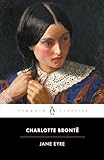
 Anne Brontë was the youngest of the six siblings — five girls and a boy — born at Haworth parsonage 18 months before her mother died. The two eldest girls died in childhood, and Anne grew up closest to Emily, with whom she created the imaginary world of Gondal. Throughout their curtailed lives (both died in early adulthood of consumption), they wrote stories and occasional journal notes about themselves and their imagined characters. When Anne left home to work as a governess, she continued writing, and later published poems and two novels as Acton Bell. Her sisters’ respective Wuthering Heights and Jane Eyre became sensations, and though The Tenant of Wildfell Hall (1848) sold well and quickly gained notoriety, Anne’s reputation was submerged after her death, especially once Charlotte wrote dismissively of her work. But with her 200th birthday coming up in 2020, she’s now seen as a proto-feminist who looked unflinchingly at life’s worst problems; her work is deceptively powerful.
Anne Brontë was the youngest of the six siblings — five girls and a boy — born at Haworth parsonage 18 months before her mother died. The two eldest girls died in childhood, and Anne grew up closest to Emily, with whom she created the imaginary world of Gondal. Throughout their curtailed lives (both died in early adulthood of consumption), they wrote stories and occasional journal notes about themselves and their imagined characters. When Anne left home to work as a governess, she continued writing, and later published poems and two novels as Acton Bell. Her sisters’ respective Wuthering Heights and Jane Eyre became sensations, and though The Tenant of Wildfell Hall (1848) sold well and quickly gained notoriety, Anne’s reputation was submerged after her death, especially once Charlotte wrote dismissively of her work. But with her 200th birthday coming up in 2020, she’s now seen as a proto-feminist who looked unflinchingly at life’s worst problems; her work is deceptively powerful.
Anne didn’t leave many private writings, and she’s difficult to know. Her published poems are often religious and nature-inspired, but one can see they’re reinforced with steel. Away from home, caring for difficult children under indifferent employers, she wrote of loneliness and low spirits; most of her poetry is a summons to courage, with God as the adrenaline shot. Some of her poems, though, pulse with huge personal feeling that has nowhere to go; “Self-Communion” (1847-8), for instance, talks of others “whose love may freely gush and flow,” and “whose dreams of bliss were not in vain.” In the end, the passion is subsumed again. Biographers have speculated about whether Anne loved a young curate, William Weightman, but there isn’t much evidence to go on, and her work keeps her deepest self-communing private.
In Happy Valley, Catherine does the same, submerging her pain beneath a preternaturally calm surface much of the time. For her, there’s little sense of a god or any other consolation for suffering, but there’s the moral imperative, similar to Anne’s, that life must plod on, that this is the way things are. So many people depend on Catherine that she can’t collapse, however close to a breakdown she gets. Her sister Clare (Siobhan Finneran) is a difficult, fragile sibling, depending on Catherine to run much of her life. When Catherine leaves her at a party to pursue the criminal Royce, her absence precipitates Clare’s furious relapse into drinking. That night, she weaves off towards the pub, while Catherine, cracking at last, screams that the door will be locked when she tries to come home, and that she should “remember there’s a fellow out there murdering and mutilating vulnerable women wandering about at night on their own.” But within minutes, Catherine is out looking for her again, watching as she throws up in the square, putting her to bed with a loving note, and returning to harness at the police station in the morning. The sibling relationship here is complex and realistic, showing how family can lock people in.
 Anne Brontë was also tied to her family. She seems to have accepted her role as her father’s “dear little Anne,” mild and placating, while privately showing more strength than her siblings. Given their propensity to run from adult life and return home, Anne was the only one to really support herself financially. Her withdrawal into herself is understandable: she lost her beloved Emily five months before her own death, and she also dealt with an addict sibling. Her brother Branwell fell apart after an affair with the mother of the boy he was tutoring at Thorp Green, the grand house near York where Anne was governess. Horrified, she witnessed Branwell slowly kill himself with alcohol and opium, burdening her with what Charlotte called “the terrible effects of talents misused and faculties abused.” Some of Branwell’s final writings are pitiable notes to a friend begging for “fivepence worth of gin,” a hard contrast to his earlier plans to be a great author or painter. Anne’s determination to live her own life, and write her clear-eyed work as she saw fit, seems to have come out of his fate. In her semi-autobiographical first novel Agnes Grey (1847), she wrote: “The ties that bind us to life are tougher than you can imagine, or than anyone can who has not felt how roughly they may be pulled without breaking.” Catherine and Anne are the sisters who know their strength, and accept the roles their family members give them.
Anne Brontë was also tied to her family. She seems to have accepted her role as her father’s “dear little Anne,” mild and placating, while privately showing more strength than her siblings. Given their propensity to run from adult life and return home, Anne was the only one to really support herself financially. Her withdrawal into herself is understandable: she lost her beloved Emily five months before her own death, and she also dealt with an addict sibling. Her brother Branwell fell apart after an affair with the mother of the boy he was tutoring at Thorp Green, the grand house near York where Anne was governess. Horrified, she witnessed Branwell slowly kill himself with alcohol and opium, burdening her with what Charlotte called “the terrible effects of talents misused and faculties abused.” Some of Branwell’s final writings are pitiable notes to a friend begging for “fivepence worth of gin,” a hard contrast to his earlier plans to be a great author or painter. Anne’s determination to live her own life, and write her clear-eyed work as she saw fit, seems to have come out of his fate. In her semi-autobiographical first novel Agnes Grey (1847), she wrote: “The ties that bind us to life are tougher than you can imagine, or than anyone can who has not felt how roughly they may be pulled without breaking.” Catherine and Anne are the sisters who know their strength, and accept the roles their family members give them.
Tough women proliferate in Anne’s books. The title character in Agnes Grey is a governess in charge of uncontrollable brats, noting rather drily, “[I]s not active employment…the surest antidote for despair?” She carries on stoically until a parson, Edward Weston, declares his love for her and she can marry and give up work. Though it’s a Cinderella variant, scholars have noted that Agnes undergoes no real change, unusual for a 19th-century bildungsroman. Agnes simply goes on, unchanging, because she must. Like Catherine, her static quality defines her and makes her strong.
Even tougher, and more shocking in the book’s time, is Helen Graham of The Tenant of Wildfell Hall, who flees her abusive alcoholic husband with her young son and tries to begin a new life. Helen’s diary makes up part of the novel, and is full of desperate scenes; the husband gets their boy hooked on drinking, for one. The abuse wasn’t what stunned the Victorian audience; it was instead Helen’s refusal to submit to her husband, illegally running away with their child. But even now, the abuse and high drama aren’t really the point of the book. It’s the character’s endurance that holds readers. As Helen puts it, “What the world stigmatizes as romantic, is often more nearly allied to the truth than is commonly supposed.” The romantic, that is to say highly dramatic, plot is the servant of Anne Brontë’s need to push forward her truth.
Happy Valley also has its luridness, but this is similarly kept in its place relative to Catherine’s strong character. Tommy Lee Royce has raped not only Becky, but also Ann Gallagher (Charlie Murphy), the kidnap victim in Season One. Catherine has to tell Ann’s father about the assault: “She couldn’t face telling you herself,” she says, “so she asked me to…You do need to know.” It’s a distressing scene, brilliantly played by Lancashire, but again, the show takes care to point out that rape doesn’t define Ann’s character. Catherine goes on to say, “She’s tough. She’s clever. She’s dealing with it.” Like Anne Bronte, Ann is a strong young woman who loses her mother and insists on making her own way in life. In Season Two, Ann has joined the police force, working with Catherine, making headway on cases; the assault is behind her, just one part of her story. Critics have recently commented on male TV writers’ casual use of rape as female characters’ only motivation to get angry and act — Game of Thrones has received plenty of flack for this — but Happy Valley’s writer, Sally Wainwright, deals with it quite differently. She told The Guardian, “Women are more heroic. The banality of the day-to-day; the reality of it; coping with problems on a daily basis.” The rape, abuse, and addiction fit into everyday life. They’re not the centre of things, and the protagonists push on with work and family like Sisyphus moving uphill.
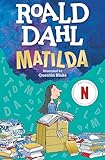 Even the horrors of kidnap, assault, and murder take a backseat to Catherine’s characterization. In one of the show’s best moments, a drunken Ann, who has just shagged a stranger outside a bar, looks at Catherine and says, “So much goodness. So much bigness…It’s like you embody what God is.” This appellation feels exactly right — as do Catherine’s other colleagues’ secret nicknames for her: “Brunhilde” and “Miss Trunchbull,” after Roald Dahl’s headmistress in Matilda. The Victorian Angel in the House hasn’t died; she has mutated from the quiet, calm keeper of domestic bliss into someone huge and ferocious, working at all costs to keep others safe, even the least sympathetic characters. This theme is rooted in Anne Brontë’s work — Helen, for instance, cares for her abusive husband when he lies dying and begging for her to save his soul. Happy Valley’s Catherine takes this trope further, saving Royce’s life, consoling his manipulated prison girlfriend, and raising her grandson in spite of her clear ambivalence towards him as Royce’s child.
Even the horrors of kidnap, assault, and murder take a backseat to Catherine’s characterization. In one of the show’s best moments, a drunken Ann, who has just shagged a stranger outside a bar, looks at Catherine and says, “So much goodness. So much bigness…It’s like you embody what God is.” This appellation feels exactly right — as do Catherine’s other colleagues’ secret nicknames for her: “Brunhilde” and “Miss Trunchbull,” after Roald Dahl’s headmistress in Matilda. The Victorian Angel in the House hasn’t died; she has mutated from the quiet, calm keeper of domestic bliss into someone huge and ferocious, working at all costs to keep others safe, even the least sympathetic characters. This theme is rooted in Anne Brontë’s work — Helen, for instance, cares for her abusive husband when he lies dying and begging for her to save his soul. Happy Valley’s Catherine takes this trope further, saving Royce’s life, consoling his manipulated prison girlfriend, and raising her grandson in spite of her clear ambivalence towards him as Royce’s child.
The visibly tired Catherine cries often, and gets through the pain of every Christmas with false “big smiles.” Anne Brontë’s protagonists are also emotionally driven; Helen says, “[S]miles and tears are so alike with me, they are neither of them confined to any particular feelings: I often cry when I am happy, and smile when I am sad.” For both Happy Valley and Anne Brontë, the nature of feeling isn’t important. It’s the engine for correcting injustice, keeping women in perpetual forward motion.








